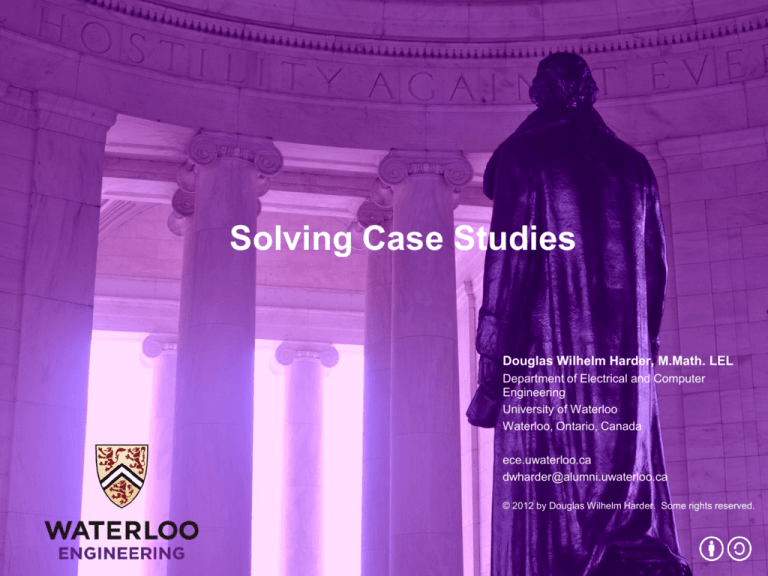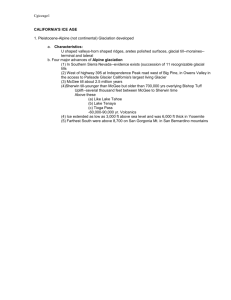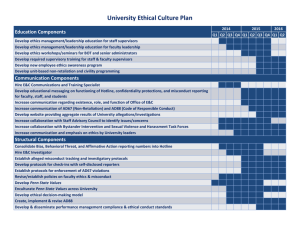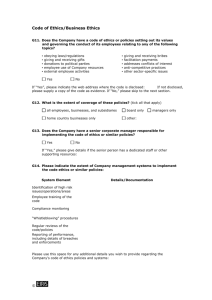
Solving Case Studies
Douglas Wilhelm Harder, M.Math. LEL
Department of Electrical and Computer
Engineering
University of Waterloo
Waterloo, Ontario, Canada
ece.uwaterloo.ca
dwharder@alumni.uwaterloo.ca
© 2012 by Douglas Wilhelm Harder. Some rights reserved.
Ethics: A Case Study
Outline
An introduction to the engineering profession, including:
– Standards and safety
– Law: Charter of Rights and Freedoms, contracts, torts, negligent
malpractice, forms of carrying on business
– Intellectual property (patents, trade marks, copyrights and
industrial designs)
– Professional practice
• Professional Engineers Act
• Professional misconduct and sexual harassment
– Alternative dispute resolution
– Labour Relations and Employment Law
– Environmental Law
2
Ethics: A Case Study
Case Studies
The standard means by which a student is tested with
respect to his or her knowledge of ethics and
professional practice
A scenario is provided and the student must identify
instances of professional misconduct and must
recommend ethical courses of action
3
Ethics: A Case Study
Case Studies
The solution to a case study must always be in essay
form
– A correct answer that is in point form will result in a failing grade
on the Professional Practice Examination
– All forms of human communication consist of:
• An introduction including relevant background
• A body
• A conclusion, including a summary and recommendations
4
Ethics: A Case Study
Case Study
Steps in solving a case study:
–
–
–
–
–
Who are the main players involved?
What are their relationships?
Identify relevant actions
What are the relevant statutes, codes, regulations?
Determine professional misconduct and ethical responses
5
Ethics: A Case Study
6
Case Study
Steps in solving a case study:
User: D-Kuru
The Players involved
Their Relationships
Identify their actions
What Statutes apply?
Determine professional Misconduct and ethical responses
Ethics: A Case Study
Case Study
“PRISM” may be a forced acronym, but it’s better than:
READ—EGAD!—SUMMARIZE
Read
Ethical issues
Generation of alternatives
Analysis
Decision
Summary
7
Ethics: A Case Study
Case Study 1
A case study from a previous Professional Practice
Examination:
McGee1 is a professional engineer who is employed on a full-time basis by
EngrCIS, Inc., a large engineering firm. However, for a number of reasons,
McGee is unhappy and for some time has been thinking about looking for a
new job. Although McGee’s current employment at EngrCIS provides good
pay and interesting work, McGee is finding it difficult to work with DiNozzo1,
a professional engineer who is McGee’s supervisor at EngrCIS.
1 names
taken from Paramount Network Television program NCIS
8
Ethics: A Case Study
Case Study 1
In the year since McGee joined the company, DiNozzo has frequently made
derogatory jokes and remarks about McGee’s race and religion—
sometimes even in meetings with other engineers and clients. On many
occasions, McGee has informed DiNozzo that such remarks are offensive,
hurtful, and inappropriate and has asked DiNozzo to stop. DiNozzo refuses
to do so and says that McGee should “toughen up and learn to take a joke”
if McGee expects to have a successful career at EngrCIS.
Recently, McGee met with a professional engineer colleague, Sciuto1, who
is a vice president at NYCE, Ltd., another engineering company. Upon
hearing that McGee was interested in considering other opportunities,
Sciuto offered McGee a part-time job to work in the evenings and on
weekends on a trial basis as an engineer for NYCE. McGee would work
under Sciuto’s supervision with the intent that in a few months, if McGee
preferred working at NYCE, McGee would resign from EngrCIS and
become a full-time employee of NYCE.
1 names
taken from Paramount Network Television program NCIS
9
Ethics: A Case Study
The Players
The players are:
–
–
–
–
–
McGee, P.Eng.
DiNozzo , P.Eng.
EngrCIS
Sciuto, P.Eng.
NYCE
10
Ethics: A Case Study
Relationships
Their relationships are:
–
–
–
–
–
McGee and DiNozzo are employed by EngrCIS
DiNozzo is McGee’s supervisor
McGee and his collegue
The colleague is a V.P. at NYCE
McGee has the option of
contracting with NYCE
11
Ethics: A Case Study
Identify the Actions
The players are:
– DiNozzo has been harassing McGee
– The V.P. has made a contract offer to McGee
12
Ethics: A Case Study
Statutes, Codes, Regulations, etc.
In this case, the relevant statutes, codes,
regulations, etc., include:
– The Professional Engineers Act, including
• The requirement that a Certificate of Authorization is required for
any engineering services offered to the public
• The Code of Ethics
• The definition of professional misconduct
– The Ontario Human Rights Code
– The Ontario Occupational Health and Safety Act
13
Ethics: A Case Study
Statutes, Codes, Regulations, etc.
To the practitioner’s employer, he or she
• Has a duty to act at all times with fairness and
loyalty (77.1);
• Shall act in professional engineering matters
– As a faithful agent or trustee, and
– Shall regard as confidential information obtained by the practitioner as
to the business affairs, technical methods or processes of an employer
(77.3); and
• Shall avoid or disclose a conflict of interest that might influence the
practitioner’s actions or judgment (77.3)
14
Ethics: A Case Study
Statutes, Codes, Regulations, etc.
To other members of the profession, he or she
• Has a duty to act at all times with fairness, loyalty (77.1),
courtesy and good faith (77.7);
• Shall not
– Accept an engagement to review the work of another for the same
employer except with the knowledge of the other practitioner or except
where the connection of the other practitioner with the work has been
terminated, nor
– Maliciously injure the reputation of another practitioner (77.7); and
• Shall
– Give proper credit for engineering work,
– Provide opportunity for professional development and advancement of
the practitioner’s associates and subordinates, and
– Extend the effectiveness of the profession through the interchange of
engineering information and experience (77.7).
15
Ethics: A Case Study
Statutes, Codes, Regulations, etc.
Certificate of authorization
12. (2) No person shall offer to the public or engage in the business
of providing to the public services that are within the practice of
professional engineering except under and in accordance with a certificate
of authorization.
– Both during the mid-term and final examinations of this course,
you will have access to the Code of Ethics and the definition of
professional misconduct—you will be required to quote the
appropriate item
– You will not be required to quote other section numbers from the
Professional Engineers Act or the regulations
16
Ethics: A Case Study
Statutes, Codes, Regulations, etc.
The Human Rights Code prohibits discrimination
on the the following grounds:
Race
Ancestry
Colour
Ethnic origin
Creed
Sex
Gender identity
Gender expression
Marital status
Family status
Record of Offences
Reprisal
The receipt of public assistance
Place of origin
Citizenship
Sexual orientation
Age
Disability
Association
Discrimination, n.
The action of discriminating; the perceiving, noting, or making a distinction
or difference between things; a distinction (made with the mind, or in action).
Specifically, the making of distinctions prejudicial to people of a different race
or colour from oneself; racial discrimination.
Oxford English Dictionary
17
Ethics: A Case Study
Statutes, Codes, Regulations, etc.
Policies, violence and harassment
32.0.1(1)(b) An employer shall prepare a policy with respect to
harassment.
Program, harassment
32.0.6 (1) An employer shall develop and maintain a program to implement
the policy with respect to workplace harassment required under clause
32.0.1(1)(b).
Contents
(2) Without limiting the generality of subsection (1), the program shall,
(a) include measures and procedures for workers to report incidents of
workplace harassment to the employer or supervisor;
(b) set out how the employer will investigate and deal with incidents and
complaints of workplace harassment; and
(c) include any prescribed elements.
18
Ethics: A Case Study
Determine Professional Misconduct
and Ethical Responses
One instance of professional misconduct is
DiNozzo’s harassment of McGee
– Such harassment constitutes a violation of the
Ontario Human Rights Code as well as professional
misconduct
– For whatever reason, it seems that McGee
has not approached H.R. at EngrCIS
– Given he appears to enjoy working at EngrCIS,
it would be reasonable to give them the
opportunity to correct this violation
– If H.R. does not respond, McGee should
file a complaint with PEO
– Depending on the severity, a last step might
be to file a human rights complaint
19
Ethics: A Case Study
Determine Professional Misconduct
and Ethical Responses
McGee is being offered a contract by NYCE
– The scenario suggests that he would be
providing engineering services to NYCE
– Providing such services requires a Certificate of Authorization
– Providing such services without a C. of A.
would be a breach of Section 12(2) the Act
– A breach of the Act is professional misconduct
under 72(2)(g)
– McGee should acquire a C. of A. if he intends
to enter into such a contract
20
Ethics: A Case Study
Determine Professional Misconduct
and Ethical Responses
McGee is being offered a contract by NYCE
– The scenario suggests that he would be
providing engineering services to NYCE
– The Code of Ethics requires McGee to
• Provide, in writing, a statement to NYCE that he is
employed by EngrCIS (even if this is obvious)
• Ensure that there is no conflict in the work
performed
• Inform EngrCIS that he is entering into a contract
with NYCE
– Failure to do so would be professional
misconduct under 72(2)(i) as an
undisclosed conflict of interest
21
Ethics: A Case Study
Case Study 1
If you are simply required to respond to a case study, the
response would be an essay-based which would cover
the points provided in the past eleven pages
– Every essay must have an introduction, a body, and a conclusion
– The introduction would briefly cover the situation and explain the
approach that the body of the essay will take
– In each case, we will look at the obligations under the Code of
Ethics and issues with respect to any statutes that may have
been breached
– We conclude by summarizing the actions that should be taken
22
Ethics: A Case Study
Case Study 1
In the professional practice examination, there were
three questions asked:
(a) Comment on DiNozzo’s conduct with respect to Ontario
Regulation 941.
(b) In relation to the regulation of the practice of professional
engineering what should McGee consider doing about
DiNozzo’s conduct?
(c) Specify and explain the requirements, if any, that McGee must
satisfy in order to properly undertake such part-time
employment with NYCE.
23
Ethics: A Case Study
Case Study 1
In these questions, it specifically restricts the response
with respect to DiNozzo’s actions to the regulations—in
this case, it would be therefore only a question of
professional misconduct by harassment
– Later, we will discuss the Occupational Health and Safety Act
and the Ontario Human Rights Code
On the course web site is a model answer to the general
case study
24
Ethics: A Case Study
Case Study 2
Another case study from a previous Professional
Practice Examination:
Gibbs1, the owner of a house in the City of Waterloo, was notified by the city
that the condition of the foundation walls of his house violated the standards
set out in the city’s property standards by-law. The city, being concerned
that the foundation walls had deteriorated to the point of being structurally
unsafe, ordered Gibbs to obtain a written report by a professional engineer
as to the condition of the walls. Fornell1 prepared a report stating that he
had inspected the foundation and that the foundation walls appeared to be
“structurally sound and capable of safely sustaining the house for many
more years.”
1 names
taken from Paramount Network Television program NCIS
25
Ethics: A Case Study
Case Study 2
Gibbs submitted Fornell’s report to the city. In response, the city sent a
letter to Gibbs with a copy to Fornell pointing out the city's observations
regarding the deterioration of the walls, including evidence of significant
water permeation, together with photographs taken by the city's inspector. In
the letter, the city requested the condition of the foundation be reassessed
and a response be made to the city within two weeks. Gibbs was unaware
that Fornell would be waiting for authorization for him to spend more time on
the project and accordingly did not contact Fornell and request him to
respond. Fornell did not follow up with either Gibbs or the city.
Following a second request to Gibbs, copied to Fornell, Fornell responded
by letter to the city, advising that he had never examined the interior of the
walls, only the exterior and admitted the photographs provided by the city
indicated that the foundation was structurally unsound.
26
Ethics: A Case Study
Case Study 2
In the professional practice examination, there were two
questions asked:
(a) Comment on the services provided by Fornell, in relation to
Regulation 941. In your answer, also discuss Fornell’s conduct
regarding his dealings with the City.
(b) Fornell does not have a certificate of authorization. Does
Fornell need one under the facts described above? Explain why
or why not. What are the possible consequences to a
professional engineer of acting without a certificate of
authorization when one is required?
27
Ethics: A Case Study
Case Study 3
A third case study from a previous Professional Practice
Examination:
Duckie1, P.Eng., a senior professional engineer, established a small firm,
Mallard Engineering, to provide professional engineering services to the
public. The firm became busy very quickly and within a few months, he
hired Palmer1, a bright recent university graduate with an engineering
degree, to assist with the work. Duckie strongly believed in mentoring and
hoped that in several years, after obtaining the necessary experience
requirements and becoming a professional engineer, Palmer would assume
increasing managerial responsibility and possibly an ownership interest in
the firm.
1 names
taken from Paramount Network Television program NCIS
28
Ethics: A Case Study
Case Study 3
After about a year after Palmer joined the firm, Mallard Engineering was
asked by one of its clients to provide a formal report that included an
engineering option. Palmer performed the work on that matter and
prepared a draft of the report. Before having a chance to review Palmer’s
work, Duckie received an urgent request from another client that required
Duckie to leave on a lengthy business trip. On the way out of the office,
Duckie stopped at Palmer’s desk and said, “Sorry, but I’ll be out of the
country and tied up completely for the next three weeks, so I won’t be able
to review that report. I know that it’s due tomorrow, so go ahead and sign it
under your own name and send it to the client so that we can meet the
deadline.” Duckie was confident that that would be all right, since Palmer
has always produced outstanding work in the past. Palmer proceed to
complete the report, signed it “J. Palmer, Eng., Mallard Engineering” and
sent it to the client.
29
Ethics: A Case Study
Case Study 3
In the professional practice examination, there were
three questions asked:
(a) Discuss the conduct of both Duckie and Palmer. What, if
anything, should they be concerned about?
(b) Could Duckie or Palmer be subject to a hearing by the Discipline
Committee of PEO? Discuss.
(c) Is there anything about Duckie’s conduct relative to the Code of
Ethics that is commendable?
30
Ethics: A Case Study
Case Study 4
A third case study from a previous Professional Practice
Examination:
IBF Engineering, a large engineering firm, was hired to prepare the design
for a chemical production plant for AIC, Inc. In addition to preparing the
plant design, IBF Engineering’s duties included providing inspection
services during the construction stage of the project. The project was
completed successfully.
31
Ethics: A Case Study
Case Study 4
You are a professional engineer and have been employed on a full-time
basis for IBF Engineering for several years. You work in the Process
Division and are involved on several process design projects. You were an
important member of the design team that prepared the design for AIC Inc.’s
plant. In addition to working for IBF Engineering, you supplement your
income by occasionally undertaking work on weekends and during evenings
for Marine Engineering, Ltd., another engineering company. A colleague of
yours, who is a professional engineer at Marine Engineering, Ltd., assigns
you such work and assumes responsibility for it.
32
Ethics: A Case Study
Case Study 4
A few years after the plant was completed, AIC, Inc., decides to restructure
its operations and sell the plant. ASN Corp. has agreed to buy the plant, but
before it does so, ASN Corp. wants to satisfy itself (and its bank) that the
plant was built to proper standards and is in good physical condition. ASN
Corp. hires Marine Engineering, Ltd. to inspect the physcial plant and to
review relevant documents (including the original plans, “as-built” drawings,
and operations and maintenance logs). Marine Engineering, Ltd. is very
busy on several projects and asks you to assist with the plant inspection
and document review.
33
Ethics: A Case Study
Case Study 3
In the professional practice examination, there were
three questions asked:
(a) Discuss the appropriateness of your employment arrangements.
(b) Assuming that your employment arrangements have not
changed since the plant was designed and constructed, discuss
how you respond to Marine Engineering, Ltd.’s request for
assistance.
(c) Would you need a Certificate of Authorization to provide
services to Marine Engineering, Ltd.? Explain.
34
Ethics: A Case Study
References
[1]
[2]
Julie Vale, ECE 290 Course Notes, 2011.
Wikipedia, http://www.wikipedia.org/
These course slides are provided for the ECE 290 class. The material in it reflects
Douglas Harder’s best judgment in light of the information available to him at the
time of preparation. Any reliance on these course slides by any party for any other
purpose are the responsibility of such parties. Douglas W. Harder accepts no
responsibility for damages, if any, suffered by any party as a result of decisions
made or actions based on these course slides for any other purpose than that for
which it was intended.
35






